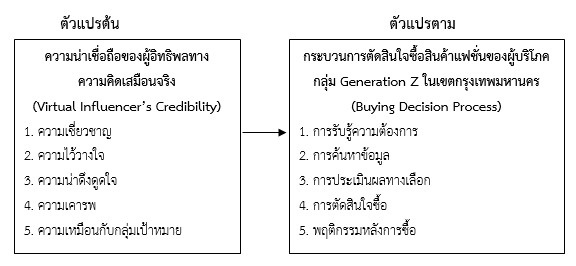Nawamin Siwasaranond Exploring the Effects of Virtual Influencer Credibility Factors on Purchasing Decision Process for Fashion Products among Generation Z in Bangkok
Main Article Content
Abstract
This research aims to 1) study the opinion level regarding trust factors of virtual influencers among Generation Z consumers in the Bangkok Province, 2) examine the opinion level regarding fashion purchasing decisions among Generation Z consumers in the Bangkok Province, and 3) investigate the relationship between opinions on trust factors of virtual influencers and opinions on fashion purchasing decisions among Generation Z consumers in the Bangkok Province using surveys as a data collection tool. The survey contents’ reliability and credibility were tested by using Cronbach's alpha with a sample of 30 participants, resulting in a confidence level of 0.62. Subsequently, 147 research participants were surveyed via questionnaire. Also, descriptive statistics and inferential statistic with Pearson's Product Moment Correlation Coefficient were employed to determine the relationship between independent and dependent variables.
The research revealed that the opinions on trust factors of virtual influencers have a positive relationship with opinions on fashion purchasing decisions among Generation Z consumers in the Bangkok Province at the highest level (r = .829), with statistical significance of 0.01. Specifically, an increase in the credibility of virtual influencers significantly influences the fashion purchasing decisions of generation Z consumers. Generation Z consumers consider various factors related to the credibility of virtual influencer, namely trust, expertise, respect, similarity to the target audience, and attractiveness when making purchase decision about fashion products.
Article Details

This work is licensed under a Creative Commons Attribution-NonCommercial-NoDerivatives 4.0 International License.
References
กอบบุญ ทองไสว. (ม.ป.ป.). อิทธิพลของ Influencer ที่มีผลต่อการตัดสินใจซื้อเวชสำอางของกลุ่มผู้บริโภคในหน่วยงาน eXta health & wellness ของบริษัท ซีพี ออลล์ จำกัด (มหาชน). บทความสาขาการตลาด คณะบริหารธุรกิจ มหาวิทยาลัยรามคำแหง. https://mmm.ru.ac.th/MMM/IS/sat17/6 214060193.pdf
กุลนาถ วรรัฐกฤติกร. (2564). คุณลักษณะของ Power influencers ที่มีผลต่อการตัดสินใจใช้บริการร้านคาเฟ่ของผู้บริโภคในประเทศไทย [วิทยานิพนธ์ปริญญามหาบัณฑิต, มหาวิทยาลัยศิลปากร]. http://it hesis-ir.su.ac.th/dspace/bitstream/123456789/3665/1/61602301.pdf
คณิศา สุดสงค์. (2563). ทัศนคติต่อการตัดสินใจซื้อไอศกรีมโฮมเมด ของผ้บูริโภค Gen Y ในเขตพื้นที่กรุงเทพมหานครและปริมณฑล [สารนิพนธ์ปริญญามหาบัณฑิต, มหาวิทยาลัยมหิดล]. https://archive.cm.mahidol.ac.th/bitstream/123456789/3940/1/TP%20MM.076%202563.pdf
จริยา แก้วหนองสังข์. (2564). อิทธิพลของบุคคลผู้มีชื่อเสียง (Influencer) ที่มีผลต่อการตัดสินใจซื้อน้ำหอมของผู้บริโภควัยทำงาน [การค้นคว้าอิสระปริญญามหาบัณฑิต, มหาวิทยาลัยกรุงเทพ].http://dspace. bu.ac.th/bitstream/123456789/5140/3/Jariya.kaew.pdf
ฉัตรเมือง เผ่ามานะเจริญ. (2565). แรงจูงใจที่มีต่อการตัดสินใจซื้อสินค้าบนแพลตฟอร์มช้อปปิ้งออนไลน์ของ
เจเนอเรชั่นแซด. วารสารวิชาการนวัตกรรมสื่อสารสังคม, 10(2), 88-104. https://so06.tci-thaijo.org /index.php/jcosci/article/view/255174/175702
ชัญญาภรณ์ แสงตะโก. (2560). อิทธิพลของ Micro-influencer ต่อการตัดสินใจซื้อสินค้า High Involvement ประเภทรถยนต์นั่งส่วนบุคคล [การค้นคว้าอิสระปริญญามหาบัณฑิต, มหาวิทยาลัยกรุงเทพ]. http:// ds pace.bu.ac.th/jspui/bitstream/123456789/3200/1/chanyaporn.saen.pdf
ชื่นสุมล บุนนาค, สุนันทา ศิริโวหาร และชฎารัตน์ อนันตกูล. (2565). คุณลักษณะของผู้มีอิทธิพลผ่านสื่อสังคมออนไลน์ที่มีผลต่อการตัดสินใจซื้อสมาร์ตโฟนของผู้บริโภคในเขตกรุงเทพมหานคร. วารสารบริหารธุรกิจเทคโนโลยีมหานคร, 19(1), 83-105. https://so04.tci-thaijo.org/index.php/jour nalmbsmut/article/view/259622/175809
ณัฏฐ์ธภา ตั้งขจรชัยศักดิ์. (2565). การศึกษาวิจัยอิทธิพลการรับรู้ด้านคุณค่าที่ส่งผลต่อการตัดสินใจซื้อเคาน์เตอร์แบรนด์สกินแคร์ ผ่านการใช้อินฟลูเอนเซอร์ของผู้บริโภค Generation Z [สารนิพนธ์ปริญญามหาบัณฑิต, มหาวิทยาลัยมหิดล]. https://archive.cm.mahidol.ac.th/bitstream/123456789/ 4668/1/TP%20BM.045%202565.pdf
นลินี สุวิสุทธิ์. (2565). คุณลักษณะของ Peer Influencers ที่มีผลต่อการตัดสินใจซื้อเสื้อผ้าแฟชั่นของผู้บริโภคเจเนอร์เรชั่นวาย (GEN Y) ในเขตกรุงเทพมหานคร กรณีศึกษาแพลตฟอร์ม TikTok [การค้นคว้าอิสระปริญญามหาบัณฑิต, มหาวิทยาลัยกรุงเทพ]. http://dspace.bu.ac.th/bitstream/123456789/ 5406/1/nalinee_suwi.pdf
นิรชา เอี่ยมชะโอด. (2563). การศึกษาทัศนคติของผู้บริโภค Generation Y ในการซื้อผลติภัณฑ์ที่เป็นมิตรต่อสิ่งแวดล้อม [สารนิพนธ์ปริญญามหาบัณฑิต, มหาวิทยาลัยมหิดล]. https://archive.cm.mahidol. ac.th/bitstream/123456789/3666/1/TP%20MS.024%202563.pdf
ภรัณยา ฆารสินธุ์. (2560). การจำแนกความแตกต่างระหว่างกลุ่ม Gen-Y และ กลุ่ม Gen-Z โดยใช้ความต้องการส่วนประสมการค้าปลีกธุรกิจ ร้านอีฟแอนบอย ในเขตกรุงเทพมหานคร. [การค้นคว้าอิสระปริญญามหาบัณฑิต, มหาวิทยาลัยหอการค้าไทย]. https://searchlib.utcc.ac.th/library/online thesis/300663.pdf
ภัทรินทร์ จิตรวศินกุล. (2564). การสร้างตัวตนในชุมชนเสมือนจริงผ่านการเล่นคอมมู กรณีศึกษาคอมมู E.O.S. วารสารมานุษยวิทยา, 4(1), 156-187. https://so06.tci-thaijo.org/index.php/jasac/ article/view/240978/168787
ภูมิ อำนวยผลวิวัฒน์. (2563). จุดจับใจด้านโฆษณาและความสนใจต่อโฆษณาวิดีโอแบบกดข้ามได้ในยูทูบของผู้บริโภคเจเนอเรชั่นซี [วิทยานิพนธ์ปริญญามหาบัณฑิต, มหาวิทยาลัยธรรมศาสตร์]. https://digital. library.tu.ac.th/tu_dc/frontend/Info/item/dc:185942#
วิสสุตา จำเนียร. (2563). ความพึงพอใจ ภาพลักษณ์ ความเชื่อมั่น และทัศนคติที่มีผลต่อความตั้งใจ ซื้อสินค้าร้านอีฟแอนด์บอย (EVEANDBOY) ของผู้บริโภค Gen Y ในเขตกรุงเทพมหานคร [สารนิพนธ์ปริญญามหาบัณฑิต, มหาวิทยาลัยมหิดล]. https://archive.cm.mahidol.ac.th/bitstream/123456789/ 3805/1/TP%20BM.055%202563.pdf
วิโรจน์ ทองชูใจ. (2563). การสื่อสารของผู้ทรงอิทธิพลทางความคิดในเครือข่ายสังคมออนไลน์และพฤติกรรมการเปิดรับสื่อสังคมออนไลน์ที่มีความสัมพันธ์ต่อการตัดสินใจซื้อสมาร์ทโฟนของผู้บริโภคกลุ่มเจเนอเรชั่นซี ในเขตกรุงเทพมหานคร [สารนิพนธ์ปริญญามหาบัณฑิต, มหาวิทยาลัยศรีนครินทรวิโรฒ]. http://ir-ithesis.swu.ac.th/dspace/bitstream/123456789/1137/1/gs611130134.pdf
สำนักงานบริหารการทะเบียน. (2566, 1 มกราคม). โครงสร้างข้อมูลสถิติจำนวนประชากร. https://stat. bora.dopa.go.th/new_stat/webPage/statByYear.php
สำนักงานพัฒนาธุรกรรมทางอิเล็กทรอนิกส์. (2565, 22 สิงหาคม). ข้อมูลผลสำรวจพฤติกรรมผู้ใช้อินเทอร์เน็ตในประเทศไทย ปี 2565 หรือ Thailand Internet User Behavior 2022 ในงาน “IUB 2022: What’s next insight and trend เจาะลึกไลฟ์สไตล์คนไทยในวันที่ขาดอินเทอร์เน็ตไม่ได้. RYT9. https://www.ryt9.com/s/prg/3349810
สุรพงษ์ การาม. (2562). ช่องทางการสื่อสารทางการตลาดของแม็คยีนส์ที่มีผลต่อการตัดสินใจซื้อของวัยรุ่นในเขตกรุงเทพมหานคร [การค้นคว้าอิสระปริญญามหาบัณฑิต, มหาวิทยาลัยกรุงเทพ]. http://dspace .bu.ac.th/bitstream/123456789/4518/3/surapong_kara.pdf
สุชัญญา สายชนะ และปัทมพร ภูมิพันธ์. (2566). อิทธิพลของการทำการตลาดแบบอาศัยบุคคลที่มีชื่อเสียง
เสมือนจริงต่อความตั้งใจใช้บริการเครือข่ายโทรศัพท์มือถือเอไอเอสและทรูของผู้บริโภคในเขตกรุงเทพมหานคร. วารสารวิชาการสังคมศาสตร์เครือข่ายวิจัยประชาชื่น, 5(2), 1-14. https://so03. tci-thaijo.org/index.php/prn/article/view/266150/179226
อภินัทธ์ ธนวัตน์. (2559). ผู้ทรงอิทธิพลทางสื่อออนไลน์ (Online Influencer) ในมุมมองของนักศึกษาหญิงกับการซื้อรองเท้าผ้าใบ Sneaker [วิทยานิพนธ์ปริญญามหาบัณฑิต, มหาวิทยาลัยมหิดล]. https:// archive.cm.mahidol.ac.th/bitstream/123456789/2277/1/TP%20MM.072%202559.pdf
อรุโณทัย แก้วอุบล. (ม.ป.ป.). การตัดสินใจซื้อสินค้าของผู้บริโภคในกรุงเทพมหานครจากการประชาสัมพันธ์ผ่านผู้ทรงอิทธิพลในโลกออนไลน์. บทความสาขาการจัดการ มหาวิทยาลัยรามคำแหง. https:// mmm.ru.ac.th/MMM/IS/sat17/6214060171.pdf
Cohen, J. (1977). Statistical power analysis for the behavioral sciences (Rev. ed.). Lawrence Erlbaum Associates.
Hair, J. F., Black, W. C., Babin, B. J., & Anderson, R. E. (2010). Multivariate data analys (7th ed). Prentice Hall.
Kotler, P. (1997). Marketing management: Analysis, planning, implementation, and control (9th ed.). Prentice Hall.
Masuda, H., Han, S. H., & Lee, J. (2022). Impacts of influencer attributes on purchase intentions in social media influencer marketing: Mediating roles of characterizations. Technological Forecasting and Social Change, 174(121246), 1-12. https://doi.org/10.1 016/j.tec hfore.2021.121246.
Selvanathan, M., Hussin, N. A. M., & Azazi, N. A. N. (2023). Students learning experiences during COVID-19: Work from home period in Malaysian Higher Learning Institutions. Teaching Public Administration, 41(1), 13-22. https://doi.org/10.1177/0144739420977900
Priporas, C. V., Stylos, N., & Fotiadis, A. K. (2017). Generation Z consumers' expectations of interactions in smart retailing: A future agenda. Computer in Human Behavior, 77, 374-381. https://doi.org/10.1016/j.chb.2017.01.058.
Wood, S. (2013). Generation Z as consumers: Trends and innovation. Institute for Emerging Issues: NC State University, 119(9), 1-3. https://archive.iei.ncsu.edu/wp-content/up loads/2013/01/GenZConsumers.pdf
Francis, T., & Hoefel, F. (2018). True gen: Generation Z and its implications for companies. Mckinsey & Company.


